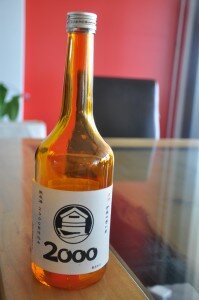We’ve looked at an awesome traditional…..and quite rare red rice Sake from this kura previously, but at a recent tasting with the fine folks from Black Market Sake in Sydney recently…..this particular Sake rocked my world.
The Mikai Shuzo kura is located in the Kyoto prefecture pretty much in the centre of the main island of Honshu. The kura (brewery) is located at the Northern tip of the prefecture, right on the Sea of Japan in the beautiful village in Ine. The funky label depicts the kura with a boat tied up outside it….. and looking at photos of Mukai Shuzo with the Blackmarket Sake crew, that is indeed what it is like…..smack bang on the waterfront and you can actually drive your boat up to the front of the kura and purchase your Sake…..my kind of drive-thru!
Kuniko is one of the few female Toji (brewers) in Japan who has taken over the reins from her Father and Kuramoto (brewery owner), Yoshihisa Mukai.
It’s a unique Sake…..the yeast used here is a 100 year old strain which has been stored at the University of Agriculture in Tokyo. Mukai asked for a sample of the strain and built it up until they had enough to produce this Sake.
This Sake would be a great one to take along to wine options…..it smells very wine-like, with a distinct lean towards the oxidative styles of the Jura…..there are also some single-malty scotch-type nuances in there as well…..must grab a bottle and plan some options evilness post-haste!
Again….Junmai is 100% pure rice sake with no additions and the Natsu no Omoide is made from Gohyakuman Goku rice, polished to 70%, the alcohol is 14.3%, the acidity 6.5 and it is recommended that the Sake be served at room temperature.
Light, pale gold in the glass with a gorgeous, alluring nose of creamy rice, dried apricots and peaches, cedar, oak & vanillin with hints of oyster shell, mirin, caramel and malt….there are some light wafts of peaty smoke and some wicked Jura-esque oxidative twangs.
In the mouth the 2000 Mukai Shuzo Natsu no Omoide is rich and beautifully complex…..it’s round and opulant but with brilliant presence and umami ache. Plenty of rich dried apricot, sea spray, caramel, toffee apple, peat, spice, vanillin and dreamy woody nuance. Amazing complexity.
Just a touch of roundness and sweetness to the finish, which is ohhh so long and moreish, point to a style of Sake that would be fantastic with a number of dishes.
Just brilliant stuff and one that is definitely on my buy list…..great stuff!
Price: $170 – Closure: Screwcap – Alcohol: 14.3% – Source: Tasting – Importer: Blackmarket Sake







Hi Dave
How do they measure acid in Sake? 6.5 is equivalent g/L of what acid?
Cheers.
Andries.
Hi Andries,
We have given some fairly technical info here, because I believe you are coming from the perspective of a wine maker wanting to know the full details? The following is our understanding of the difference between wine/sake, and are happy to stand corrected if anyone has different information, but we humbly put forward the explanation below.
The ‘sando’ or acid level in sake is relative to the number of milliliters of liquid sodium hydroxide needed to neutralise 10ml of that sake. In this case the number given is for the succinic acid being measured. Succinic acid, along with malic and lactic acid are the most abundant acids in sake. Our understanding is that with wine it is the TA (Tartaric acid) levels being measured as tartaric acid is the most abundant acid in wine along with malic and citric acids.
The amino acid content is a separate figure that is also often given for Sake, but will be stated as amino sando.
If you used a TA level from on a wine kit for a Sake and wanted to convert the final value we would need to multiply the measurement by 10*118/150 = 7.8667.
(I believe in wine the grams of acid are based on 100ml so we would multiply by 10 to get the g/L and the other numbers are because the molecular mass of succinic acid is 118 while the molecular mass of tartaric is 150).
Most of our Sake range in acidity levels between 1.6 to 3.0, but both our Mukai sake have much higher acidity levels with the Mukai Shuzo ‘Ine Mankai’ (red rice sake) being 6.1 and the ‘Natsu no Omoide’ being 6.5. Kuniko is making sure that the acidity is higher in these Sake to balance out the high levels of sweetness so that it is not too cloying, but also to add the flavour profile that she wants.
Hope that answers your questions ok?
Linda & Matt
Black Market Sake
Thanks for the question Andries & thanks for the great answer Linda & Matt!…that’s awesome and you’ve explained it a million time better than I could.
In regards to wine…TA is expressed as Tartaric Acid in our neck of the woods but in France and some other parts of Europe the end result is expressed as Sulphuric Acid….tripped up a few people that, including the big bloke Robert Parker!
Also…..touching on the Amino San-do….would I be right in saying that this is a measure of a Sake’s….for want of a better word…..plumpness or mouthfeel?……also a Sake’s Umaminess (that’s gotta be a word yeah?)…..with the amino acid glutamate being an integral companent of Umami I believe it is possible to tweak it with the San-do and Amino San-do balance?
Cheers
Dave
Sorry it’s taken me so long to get back – vintage and all that..
Thanks so much for the excellent information Linda, Matt & Dave!
Very interesting this sake gear. I suppose what I was getting at was more what Dave was talking about as I am trying to get a handle on the general level of acidity knowing different standards are used around the world. As Dave said a wine with 6g/L expressed as sulphuric is very different to 6g/L expressed as tartaric.
I think I’ve got my head around it..
Very interesting the amino acid – umami thing as well.
Cheers & look forward to learning & drinking more!
ps- have sources in the east but do you know where i might find some of these in the west?
And this is why we love wine and sake, ’cause there’s always something to learn! Possibly ’cause they taste great too….
Umami is definitely fascinating! Heston Blumenthal loves talking about it and always matches his famous Sound of the Sea dish with Sake because of the Umami factor. We laughed but there is actually an Umami Information website at http://tinyurl.com/6xs2bq9 . Strange someone created it, but still interesting! Last month when Heston was in Sydney we actually matched one of our Sake with the Sound of the Sea dish at a dinner for the Starlight Foundation. Cool stuff.
Andries, we have sold some of our Sake to Must Wine Bar in WA, so you could check out some there. Haven’t make the trip there yet ourselves, but hope to sometime in the near future to spread the Gospel according to Sake. Let us know if you’re in Sydney sometime and we will give you a Sake tasting at ours.
Matt and Linda